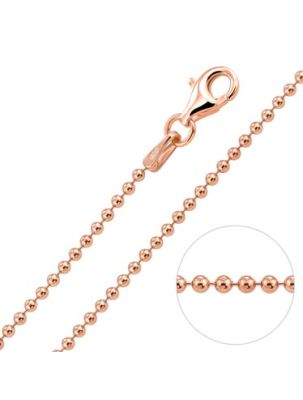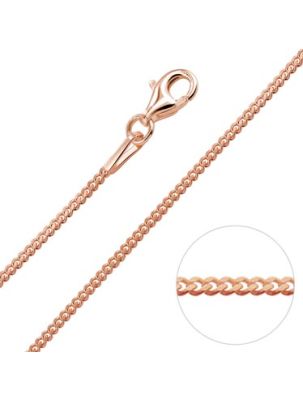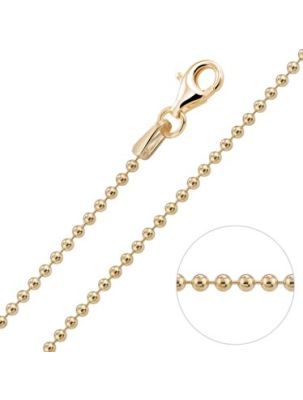Free Delivery When You spend £100+
Gold Plated Chains & Necklaces on Sterling Silver
Whilst fashion trends in jewellery come and go, the taste for Gold in jewellery continues to stand firm in its different incarnations, whether rings, bracelets, chains, necklaces and more. In this blog post we’re going to explore this trend of Gold as used as a plating on Sterling Silver Chains and the evolving mindset towards Gold fashioned onto Sterling Silver Chains to create pieces that are just as spectacular as solid Gold Chains.
Natural attraction to Gold
Little explanation is required to know that Gold itself has been historically been valued highly by cultures all across the world over thousands of years in jewellery- whether in religious or cultural practices or as a reflection of status, such as Royalty. In fact many ancient cultures closely associate Gold with the Sun, and Royalty, with the Sun being the King and life giver on Earth and solar system, it’s not wonder Gold is almost engrained in mind to be valued quite highly.
Sourced from deep beneath the earth, this precious metal has undoubtedly been one of the highest valued materials on the planet and whilst it may be difficult to put into words a single reason for the attraction to this naturally bright yellow metal, one thing is for sure- when it’s crafted into jewellery it’s charm surely magnifies tenfold.
Gold Chains themselves can be vibrant whatever the purity of Gold from which it has been crafted- whether 24ct, 22ct, 18ct, 14ct or 9ct since each emanate a different shade of Yellow suitable to our own tastes. The only difference however between each level of these purities are the relative cost. 9ct Gold being less expensive and 24ct being higher owing to the purity and concentration of gold content increasing at each increment.
Since the price of Gold being assessed on its weight, and Gold now being at all time high (at least 5-6 times more than 20 years ago) when you’re looking to accessories with Gold Chains and Necklaces, an evolving trend has emerged that maintains the luxury of the Gold appearance, yet won’t cost the earth- Gold Plated Chains on Sterling Silver.
What are Gold Plated Sterling Silver Chains?
Exactly as stated, at the heart of the chain is another precious metal, Sterling Silver. The Sterling Silver Chain is then undergoes a procedure, known as plating that coats Gold on top of the surface of the Sterling Silver, leaving no trace of the Silver colour at all and the Sterling Silver remains underneath to provide durable and sturdy support.
But this shouldn’t be confused with other types of Gold plated chains which are not on made from Sterling Silver at the heart, but on metals which aren’t precious, and are cheaper base metals. Such items are essentially not classified as precious metal jewellery but fashion, or imitation jewellery that lack the special feel and do not possess the durable substance of those crafted with Sterling Silver at their foundation. They also usually lack the same weight and feel with the coloured tones wearing away relatively quickly. Essentially, those types are made from cheaper and low cost metals such as brass, copper or steel amongst others.
In any case Gold Plated Sterling Silver Chains aren’t just available in one specific type and can vary depending upon:
- The Carat or purity of gold used to plate upon the Sterling Silver Chain - 24ct, 18ct, 9ct
- The colour of the plating used such as Yellow Gold or Rose Gold
- The grade or thickness of Gold plating
The Carat or purity of gold used to plate upon Gold Plated Sterling Silver Chains
As mentioned earlier on, Gold is available in a variety of carats. Carats in relation to Gold, is a term used to describe the proportion of Gold content is an item. Depending upon the carat of the Gold plating on the Sterling Silver Chain, the colour will vary. 24 carats is a bright yellow colour the same as that of Gold in it’s purest form as mined from the earth. At this stage is hasn’t been mixed with any other precious metals and 99.999% of it is Gold. Where as a 9ct item would be 37.5% Gold content.
Q. How do you use the carat of Gold to work out the percentage of Gold Content?
A. Without turning this into a post into maths, this percentage was calculated by taking 9 (9 for 9 carat), then dividing it by 24 and then multiplying that by 100. Why 24? 24 represents 24 carats, which is gold in it’s purest form. And of course, 100 to turn that into the percentage. Similarly if you wanted to know it for 22, 18 or 14 carat you can calculate it by replacing the 9 accordingly. In fact these numbers may even help when you look at jewellery with hallmarks and you see particular numbers stamped into them such as 375 (9ct gold), 750 (18ct Gold), 916 (22ct Gold).
Anyway, earlier we mentioned about Gold being mixed with other precious metals at carats below 24 carats. Why might Gold be added with other precious metals? Well, since Gold is a naturally soft metal, it can be difficult to work with in manufacturing and because of it’s soft nature, when paired with another precious metal it’s durability and longevity can be extended. This isn’t however so much a problem when it is plated on Sterling Silver jewellery, as opposed to when jewellery is made solely from Gold.
However, creating different carats of Gold isn’t just for the durability aspect. With various jewellery styles and fashion tastes, the varying brightness and tones of this Yellow Gold can be achieved to suit outfits, skin tones and other ideals. 24ct Gold being a shade of bright yellow , and 9ct Gold being a lighter yellow tone.
The colour such as Yellow Gold or Rose Gold
Gold plated Sterling Silver Chains aren’t only available in the natural Yellow shades of Gold either but also Rose Gold to match your existing jewellery, watches or other accessories. Our current range of Gold Plated Chains on Sterling Silver utilise a 9ct Gold Plate for both Yellow and Rose colours, with our Rose Gold Plated Chains benefitting from a hue of Rose gold that has been intentionally formulated to encompasses bright pink tones to reduce any coppery appearance. The colour is also so closely matched to Solid Gold Chains, with the great benefit of allowing you to pull off an expensive look
The grade of plating used
Knowing the grade of plating is essential to work out approximately how long the plating will last before it wears away. Plating is much itself a form of treatment onto a metal that essentially forms a barrier between the surface of the object and the air around it. How much space is in between that is known as the thickness of plating. The less plating there is, the less amount of time the colour will last before it wears away to expose the natural colour of the underlying material, in this case Sterling Silver.
However, the grade of plating used alone isn’t itself an indicator of how long the colour of Gold Plated Chain may last. In fact, depending upon the specific item itself and how it is cared for, how often it is used, or the environments it is exposed to can all have their effects. If an item is subject to continual rubbing then naturally over a period of time that layer of Gold plate may slowly reduce. Wearing away is usually gradual and may not always be equally worn away around the whole item – that depends upon how it is worn and wearing with pendants for example may wear away one area more than another.
On the other hand, it’s certainly also the case that if there is more depth of Gold plating then it will take that much longer before it fully wears away. So we need to know what the varying thicknesses of Gold that is plated on the Sterling Silver Chains.
There are various types to approaching the Plating method with Jewellery overall Whether it’s Gold Plated Chains, or other items of jewellery such as Wedding or engagement rings- a cheaper option known as Flash Plating and another methodical and carefully approached option intended to for better longevity. This other method of approach can be described as Micron Plating because it has been plated with a specific number of microns.
How are Sterling Silver Chains plated with Gold?
It’s important to quickly address this question before moving on to understand the differences between the two types of plating mentioned. Once a Sterling Silver Chain has been produced it is then galvanised with Gold by being drenched into a specially formulated liquid Gold and then several other processes.
Why is this important? What's the difference been Flash Plating and Micron Plating?
Well since Flash plating is mentioned the term Flash pretty much describe the duration that the Chain, in this case, will have been subjected to that liquid. Essentially Flash plating is just enough time to coat the surface, albeit quite thinly and economically to produce the desired colour, something similar to placing the object 'in and out'.
This is compared with Gold Plating that has a specified Micron level described. When an item is being plated, whether it be Gold or another metal such as Rhodium, to ensure proper consistency, a particular measurement is used to determine the level of thickness – known as Microns. 1 micron is equivalent to 0.001 millimetres. Whilst this may sound surprisingly thin, this is still a lot more than a flash plating and is certain to last a lot longer, relatively speaking. It's also a measured approach to ensure than the Gold Plating is equally the same all around the corners or contours of an item so that one area does not wear away faster than another, even when subjected to the same environment.
If there is more microns, does that mean my item will last longer?
Yes. But you should be aware that the thicker the micron you coat it with, the more expensive the item will be owing to the Gold use for the plating being real gold. Since Gold is higher in value the more you add the expensive it will become. Additionally, by increasing it many microns more, the difference in price between the plated item and a solid gold item may not be as much difference.
View our 9ct Gold Plated Chain Collection here
Our Current range of Gold Plated Chains available in 16 to 24" Inches length:
Yellow Gold:
Ball Bead Chain
Belcher Chain
Box Chain
Cable Trace Chain
Curb Chain
Figaro Chain
Oval Beaded Chain (18 to 30" Inches)
Rose Gold:
Ball Bead Chain
Belcher Chain
Box Chain
Cable Trace Chain
Curb Chain
Figaro Chain
Oval Beaded Chain (18 to 30" Inches)

























